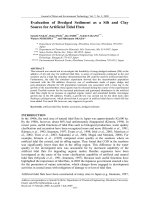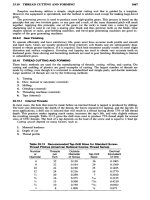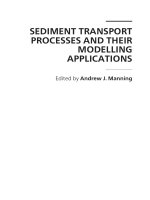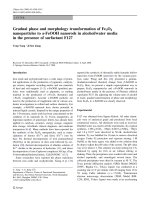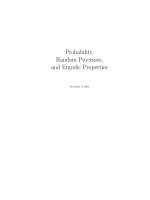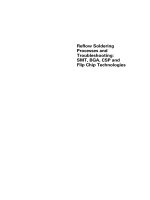SEDIMENT TRANSPORT – FLOW PROCESSES AND MORPHOLOGY pps
Bạn đang xem bản rút gọn của tài liệu. Xem và tải ngay bản đầy đủ của tài liệu tại đây (19.26 MB, 270 trang )
SEDIMENT TRANSPORT –
FLOW PROCESSES AND
MORPHOLOGY
Edited by Faruk Bhuiyan
Sediment Transport – Flow Processes and Morphology
Edited by Faruk Bhuiyan
Published by InTech
Janeza Trdine 9, 51000 Rijeka, Croatia
Copyright © 2011 InTech
All chapters are Open Access articles distributed under the Creative Commons
Non Commercial Share Alike Attribution 3.0 license, which permits to copy,
distribute, transmit, and adapt the work in any medium, so long as the original
work is properly cited. After this work has been published by InTech, authors
have the right to republish it, in whole or part, in any publication of which they
are the author, and to make other personal use of the work. Any republication,
referencing or personal use of the work must explicitly identify the original source.
Statements and opinions expressed in the chapters are these of the individual contributors
and not necessarily those of the editors or publisher. No responsibility is accepted
for the accuracy of information contained in the published articles. The publisher
assumes no responsibility for any damage or injury to persons or property arising out
of the use of any materials, instructions, methods or ideas contained in the book.
Publishing Process Manager Masa Vidovic
Technical Editor Teodora Smiljanic
Cover Designer Jan Hyrat
Image Copyright Dr. Morley Read, 2011. Used under license from Shutterstock.com
First published October, 2011
Printed in Croatia
A free online edition of this book is available at www.intechopen.com
Additional hard copies can be obtained from
Sediment Transport – Flow Processes and Morphology, Edited by Faruk Bhuiyan
p. cm.
ISBN 978-953-307-374-3
free online editions of InTech
Books and Journals can be found at
www.intechopen.com
Contents
Preface IX
Chapter 1 A Sediment Graph Model Based on SCS-CN Method 1
P. K. Bhunya, Ronny Berndtsson, Raj Deva Singh and S.N.Panda
Chapter 2 Bed Forms and Flow Mechanisms Associated with Dunes 35
Ram Balachandar and H. Prashanth Reddy
Chapter 3 Stochastic Nature of Flow Turbulence and Sediment
Particle Entrainment Over the Ripples at the Bed of
Open Channel Using Image Processing Technique 69
Alireza Keshavarzi and James Ball
Chapter 4 Stochastic and Deterministic Methods
of Computing Graded Bedload Transport 93
Faruk Bhuiyan
Chapter 5 Methods for Gully Characterization in Agricultural Croplands
Using Ground-Based Light Detection and Ranging 101
Henrique Momm, Ronald Bingner, Robert Wells and Seth Dabney
Chapter 6 Modeling Channel Response to Instream Gravel Mining 125
Dong Chen
Chapter 7 Modeling of Sediment Transport in
Surface Flow with a Grass Strip 141
Takahiro Shiono and Kuniaki Miyamoto
Chapter 8 Clear-Water Scour at Labyrinth Side
Weir Intersection Along the Bend 157
M. Emin Emiroglu
Chapter 9 On the Influence of the Nearbed Sediments
in the Oxygen Budget of a Lagunar
System: The Ria de Aveiro - Portugal 177
José Fortes Lopes
VI Contents
Chapter 10 Environmental Observations on
the Kam Tin River, Hong Kong 207
Mervyn R. Peart, Lincoln Fok and Ji Chen
Chapter 11 Unraveling Sediment Transport Along Glaciated Margins
(the Northwestern Nordic Seas) Using Quantitative X-Ray
Diffraction of Bulk (< 2mm) Sediment 225
J.T. Andrews
Chapter 12 Reconstruction of the Kinematics of Landslide
and Debris Flow Through Numerical Modeling
Supported by Multidisciplinary Data:
The 2009 Siaolin, Taiwan Landslide 249
Chien-chih Chen, Jia-Jyun Dong, Chih-Yu Kuo,
Ruey-Der Hwang, Ming-Hsu Li and Chyi-Tyi Lee
Preface
It is my pleasure to write the preface of the book “Sediment Transport - Flow and
Morphological Processes” published by Intech Open Access Publisher. The transport
of sediment in the turbulent flow comprises of complex phenomena. Although
sediment transport due to water flow is directly related with long-term and short-term
alteration of the earth's surface, which has significance in science, engineering and
environmental applications, up until now the scientific progress in quantifying the
relevant processes has been rather slow. This explains the reason for abundance of
empiricism and independent field observations in this discipline. It has been several
decades since the advent of our understanding on micro-level turbulence properties of
fluid flows that we have started to apply our knowledge on turbulence for transport in
geophysical boundary layers.
Intech Open Access Publisher has taken a good step to publish a series of books on the
issues of sediment transport. The participation to the current book is by special
invitation to authors selected based on their previous contributions in recognized
scientific journals. Consequently, contents of the chapters are the reflections of the
authors’ research thoughts.
This book provides indications on current knowledge, research and applications of
sediment transport processes. The first three chapters of the book present basic and
advanced knowledge on flow mechanisms and transport. These are followed by
examples of modeling efforts and individual case studies on erosion-deposition and
their environmental consequences. I believe that the materials of this book would help
a wide range of readers to update their insight on fluvial transport processes.
Finally, I would like to thank Intech Open Access Publisher for inviting me to
contribute as a book editor. Special thanks are also due to the Publishing Process
Manager for her cooperation and help during preparation of the book.
Dr Faruk Bhuiyan
Department of Water Resources Engineering
Bangladesh University of Engineering & Technology (BUET), Dhaka,
Bangladesh
1
A Sediment Graph Model Based
on SCS-CN Method
P. K. Bhunya
1
, Ronny Berndtsson
2
,
Raj Deva Singh
1
and S.N. Panda
3
1
National Institute of Hydrology, Roorkee, Uttarakhand
2
Dept. of Water Resources Engineering, Lund University, Lund,
3
Indian Institute of Technology, Kharagpur WB
1,3
India
2
Sweden
1. Introduction
Sediment is fragmented material primarily formed by the physical and chemical
disintegration of rocks from the earth's crust. For example, physical disintegration means
where the material is broken down by human interference or can be due to the construction
or engineering works. Similarly chemical disintegration is by chemicals in fluids, wind,
water or ice and/or by the force of gravity acting on the particle itself. The estimation of
sediment yield is needed for studies of reservoir sedimentation, river morphology and soil
and water conservation planning. However, sediment yield estimate of a watershed is
difficult as it results due to a complex interaction between topographical, geological and soil
characteristics. In spite of extensive studies on the erosion process and sediment transport
modelling, there exists a lack of universally accepted sediment yield formulae (Bhunya et al.
2010). The conditions that will transport sediment are needed for engineering problems, for
example, during canal construction, channel maintenance etc. Interpreting ancient
sediments; most sediments are laid down under processes associated with flowing water
like rivers, ocean currents and tides.
Usually, the transport of particles by rolling, sliding and saltating is called bed-load
transport, while the suspended particles are transported as suspended load transport. The
suspended load may also include the fine silt particles brought into suspension from the
catchment area rather than from, the streambed material (bed material load) and is called
the wash load. An important characteristic of wash load is that its concentration is
approximately uniform for all points of the cross-section of a river. This implies that only a
single point measurement is sufficient to determine the cross-section integrated wash-load
transport by multiplying with discharge. In estuaries clay and silt concentrations are
generally not uniformly distributed.
Bed load refers to the sediment which is in almost continuous contact with the bed, carried
forward by rolling, sliding or hopping. Suspended load refers to that part of the total sediment
transport which is maintained in suspension by turbulence in the flowing water for
considerable periods of time without contact with the stream bed. It moves with practically
Sediment Transport – Flow Processes and Morphology
2
the same velocity as that of the flowing water. That part of the suspended load which is
composed of particle sizes smaller than those found in appreciable quantities in the bed
material. It is in near-permanent suspension and therefore, is transported through the
stream without deposition. The discharge of the wash load through a reach depends only
on the rate with which these particles become available in the catchment area and not on
the transport capacity of the flow. Fluid flow and sediment transport are obviously linked
to the formation of primary sedimentary structures. Here in this chapter, we tackle the
question of how sediment moves in response to flowing water that flows in one direction.
2. Fluid flow and sediment transport
The action of sediment transport which is maintained in the flowing water is typically due
to a combination of the force of gravity acting on the sediment and/or the movement of the
fluid. A schematic diagram of these forces in a flowing water is shown in Figure 1. The
bottom plate is fixed and the top plate is accelerated by applying some force that acts from
left to right. The upper plate will be accelerated to some terminal velocity and the fluid
between the plate will be set into motion. Terminal velocity is achieved when the applied
force is balanced by a resisting force (shown as an equal but opposite force applied by the
stationary bottom plate).
Fig. 1. Varying forces acting on flowing water along the flow depth
The shear stress transfers momentum (mass times velocity) through the fluid to maintain the
linear velocity profile. The magnitude of the shear stress is equal to the force that is applied
to the top plate. The relationship between the shear stress, the fluid viscosity and the
velocity gradient is given by:
du
dy
(1a)
A Sediment Graph Model Based on SCS-CN Method
3
Where u is the velocity, y is the fluid depth at this point as given in figure, is the fluid
viscosity, and
is the shear stress.
From this relationship we can determine the velocity at any point within the column of
fluid. Rearranging the terms:
/
du
dy
or ( / )dy du
or (/)
y
u
y
c
(1b)
where c (the constant of integration) is the velocity at y=0 (where u=0) such that:
y
u
y
From this relationship we can see the following:
a.
That the velocity varies in a linear fashion from 0 at the bottom plate (y=0) to some
maximum at the highest position (i.e., at the top plate).
b.
That as the applied force (equal to ) increases so does the velocity at every point above
the lower plate.
c.
That as the viscosity increases the velocity at any point above the lower plate decreases.
Driving force is only the force applied to the upper, moving plate, and the shear stress (force
per unit area) within the fluid is equal to the force that is applied to the upper plate. Fluid
momentum is transferred through the fluid due to viscosity.
3. Fluid gravity flows
Water flowing down a slope in response to gravity e.g. in rivers, the driving force is the
down slope component of gravity acting on the mass of fluid; more complicated because the
deeper into the flow the greater the weight of overlying fluid. In reference to Figure 2 that
shows the variation in velocity along the flowing water, D is the flow depth and y is some
height above the boundary, FG is the force of gravity acting on a block of fluid with
dimensions, (D-y) x 1 x 1; here y is the height above the lower boundary,
is the slope of the
water surface, it may be noted here that the depth is uniform so that this is also the slope of
the lower boundary, and
y
is the shear stress that is acting across the bottom of the block
of fluid and it is the down slope component of the weight of fluid in the block at some
height y above the boundary.
Fig. 2. Variation in velocity for depth
Sediment Transport – Flow Processes and Morphology
4
For this general situation,
y
, the shear stress acting on the bottom of such a block of fluid
that is some distance
y above the bed can be expressed as follows:
( )11sin()
y
gD y
(2)
The first term in the above equation i.e.
()11gD y
is the weight of water in the block
and Sin () is the proportion of that weight that is acting down the slope. Clearly, the
deeper within the water i.e. with decreasing y the greater the shear stress acting across any
plane within the flow. At the boundary y = 0, the shear stress is greatest and is referred to as
the boundary shear stress (
o
); this is the force per unit area acting on the bed which is
available to move sediment.
Setting y=0:
0
()sin()gD y
and
y
du
d
y
(3a)
From the above equations, we get the following velocity distribution for such flows by
substituting
/()sin()/du dy g D y
(3b)
Integrating with respect to y:
2
() ( /2)
y
gSin gSin
du
ud
y
D
y
d
y
c
y
D
y
c
dy
(4)
Where c is the constant of integration and equal to the velocity at the boundary (Uy=0) such
that:
2
sin
2
y
gy
uyD
(5)
Fig. 3. Variation in velocity for depth
Velocity varies as an exponential function from 0 at the boundary to some maximum at the
water surface; this relationship applies to:
A Sediment Graph Model Based on SCS-CN Method
5
a. Steady flows: not varying in velocity or depth over time.
b.
Uniform flows: not varying in velocity or depth along the channel.
c.
Laminar flows: see next section.
3.1 The classification of fluid gravity flows
3.1.1 Flow Reynolds’ Number (R)
Reynolds’s experiments involved injecting a dye streak into fluid moving at constant
velocity through a transparent tube. Fluid type, tube diameter and the velocity of the flow
through the tube were varied, and the three types of flows that were classified are as
follows: (a) Laminar Flow: every fluid molecule followed a straight path that was parallel to
the boundaries of the tube, (b) Transitional Flow: every fluid molecule followed wavy but
parallel path that was not parallel to the boundaries of the tube, and (c) Turbulent Flow:
every fluid molecule followed very complex path that led to a mixing of the dye. Reynolds’s
combined these variables into a dimensionless combination now known as the Flow
Reynolds’ Number (
R) where:
UD
R
(6a)
Where U is the velocity of the flow, is the density of the fluid , D is the diameter of the
tube, and is the fluid’s dynamic viscosity. Flow Reynolds’ number is often expressed in
terms of the fluid’s kinematic viscosity () equally expressed as units are m
2
/s) and
UD
R
(6b)
The value of R determine the type of flows in the following manner:
a.
Laminar flows: R <1000
b.
Transitional flows: 1000 < R <2000
c. Turbulent flows: R >2000
Fig. 4. Reynolds’s experiments for different types of flows
Sediment Transport – Flow Processes and Morphology
6
In laminar flows, the fluid momentum is transferred only by viscous shear; a moving layer
of fluid drags the underlying fluid along due to viscosity (see the left diagram, below). The
velocity distribution in turbulent flows has a strong velocity gradient near the boundary and
more uniform velocity (an average) well above the boundary. The more uniform
distribution well above the boundary reflects the fact that fluid momentum is being
transferred not only by viscous shear. The chaotic mixing that takes place also transfers
momentum through the flow. The movement of fluid up and down in the flow, due to
turbulence, more evenly distributes the velocity, low speed fluid moves upward from the
boundary and high speed fluid in the outer layer moves upward and downward. This leads
to a redistribution of fluid momentum.
Fig. 5. Variation in velocity for depth at three different types of flows
Turbulent flows are made up of two regions. And there is an inner region near the boundary
that is dominated by viscous shear i.e.,
y
du
dy
(7)
And, an outer region that is dominated by turbulent shear which focus on transfer of fluid
momentum by the movement of the fluid up and down in the flow.
y
du du
dy dy
(8)
Where is the eddy viscosity which reflects the efficiency by which turbulence transfers
momentum through the flow.
A Sediment Graph Model Based on SCS-CN Method
7
Fig. 6. Two regions of turbulent shear
As a result, the formula for determining the velocity distribution of a laminar flow cannot be
used to determine the distribution for a turbulent flow as it neglects the transfer of
momentum by turbulence. Experimentally, determined formulae are used to determine the
velocity distribution in turbulent flows e.g. the Law of the Wall for rough boundaries under
turbulent flows:
*
2.3
8.5 log
y
o
u
y
Uy
; y
0
(= d/30),
*0/
U
and
0
()gDSin
(9)
Where is Von Karman’s constant which is generally taken 0.41 for clear water flows
lacking sediment, y is the height above the boundary, y
0
(= d/30) and d is grain size, and U*
is the shear velocity of the flow. If the flow depth and shear velocity are known, as well as
the bed roughness, this formula can be used to determine the velocity at any height y above
the boundary.
*
0
2.3
8.5 log
y
y
uU
y
(10a)
*
2.3
8.5 lo
g
()
y
uU gDSin
(10b)
The above formula may be used to estimate the average velocity of a turbulent flow by
setting y to 0.4 times the depth of the flow i.e. y = 0.4D. Experiments have shown that the
average velocity is at 40% of the depth of the flow above the boundary.
Sediment Transport – Flow Processes and Morphology
8
3.1.2 Flow Froude Number (F)
Classification of flows according to their water surface behaviour, is an important part of the
basis for classification of flow regime
a.
F < 1 has a sub critical flow (tranquil flow)
b. F = 1 has a critical flow
c.
F > 1 has a supercritical flow (shooting flow)
Flow Froude Number (F) is defined as follow:
gD
U
F
(11)
gD = the celerity (speed of propagation) of gravity waves on a water surface.
F < 1, U < gD : water surface waves will propagate upstream because they move faster
than the current. Bed forms are not in phase with the water surface.
F > 1, U > gD : water surface waves will be swept downstream because the current is
moving faster than they can propagate upstream. Bed forms are in phase with the water
surface.
In sedimentology the Froude number, is important to predict the type of bed form that will
develop on a bed of mobile sediment.
Fig. 7. Classification of flows according to degree of Froude Number
A Sediment Graph Model Based on SCS-CN Method
9
3.2 Velocity distribution, in turbulent flows
Earlier we saw that for laminar flows the velocity distribution could be determined from Eq.
(4). Eq. (8). Fig. 7 shows the turbulent flows and the corresponding two regions. As per the
Law of the Wall for rough boundaries under turbulent flow depth, the shear velocity are
known along with the bed roughness, and in such cases Eq. (10) can be used to determine
the velocity at any height y above the boundary.
3.3 Subdivisions of turbulent flows
Turbulent flows can be divided into three layers: (i) Viscous Sub layer is the region near the
boundary that is dominated by viscous shear and quasi-laminar flow which is also referred
to, inaccurately, as the laminar layer, (ii) Transition Layer lies intermediate between quasi-
laminar and fully turbulent flow, and (iii) Outer Layer which is fully turbulent and
momentum transfer is dominated by turbulent shear.
3.4 Viscous sub layer (VSL)
The thickness of the VSL () is known from experiments to be related to the kinematic
viscosity and the shear velocity of the flow by:
*
12
U
(12)
It ranges from a fraction of a millimetre to several millimetres thick, and the thickness of the
VSL particularly important in comparison to size of grains (d) on the bed. Next it shall be
discussed about the forces that act on the grains and the variation of these relationships. The
Boundary Reynolds’ Number (
R*) is used to determine the relationship between and d:
*
*
UD
R
(13)
A key question is at what value of R is the diameter of the grains on the bed equal to the
thickness of the VSL?
Given that
*
12
U
, the condition exists when = d, and by substituting this relationship in R
*
*
*
UD
R
=12, thus
R* < 12
> d
R* = 12 d = d
R* > 12
< d
Turbulent boundaries are classified on the basis of the relationship between thickness of the
VSL and the size of the bed material. Given that there is normally a range in grain size on
the boundary, the following shows the classification (Fig. 8):
At the boundary of a turbulent flow the average boundary shear stress (
o
) can be
determined using the same relationship, as for a laminar flow. In the viscous sub layer
viscous shear predominates so that the same relationship exists, as given in Eqs. (3a, 8 and 9)
that applies to steady, uniform turbulent flows.
Boundary shear stress governs the power of the current to move sediment; specifically,
erosion and deposition depend on the change in boundary shear stress in the downstream
Sediment Transport – Flow Processes and Morphology
10
direction. In general, sediment transport rate (q
s
) is the amount of sediment that is moved by
a current that increases with increasing boundary shear stress. When
o
increases
downstream, so does the sediment transport rate; this leads to erosion of the bed providing
that a
o
that is sufficient to move the sediment. When
o
decreases along downstream, so
does the sediment transport rate; this leads to deposition of sediment on the bed. Variation
in
o
along the flow due to turbulence leads to a pattern of erosion and deposition on the bed
of a mobile sediment. This phenomena is given in Fig. 9.
(a) For R* < 5 is smooth
(b) For 5<R* < 70 is transitional
(c) For R* > 70 is Rough
Fig. 8. Classification of flows according to degree of Boundary Reynolds’ Number
A Sediment Graph Model Based on SCS-CN Method
11
Fig. 9. Pattern of bed erosion and deposition according to variation of shear stress.
3.4.1 Large scale structures of the outer layer
Secondary flows involves a rotating component of the motion of fluid about an axis that is
parallel to the mean flow direction. Commonly there are two or more such rotating
structures extending parallel to each other.
Fig. 10. Eddies about the axes perpendicular to the flow direction.
Sediment Transport – Flow Processes and Morphology
12
In meandering channels, characterized by a sinusoidal channel form, counter-rotating spiral
cells alternate from side to side along the channel.
Eddies are components of turbulence that
rotate about axes that are perpendicular to the mean flow direction. Smaller scale than
secondary flows moves downstream with the current at a speed of approximately 80% of
the water surface velocity (U
). Eddies move up and down within the flow as the travel
downstream, and this lead to variation in boundary shear stress over time and along the
flow direction. Some eddies are created by the topography of the bed. In the lee of a
negative step on the bed (see figure below) the flow separates from the boundary (“s” in the
figure) and reattaches downstream (“a” in the figure). A
roller eddy develops between the
point of separation and the point of attachment. Asymmetric bed forms (see next chapter)
develop similar eddies.
Fig. 11. Asymmetric bed forms
3.4.2 Small scale structures of the viscous sub layer
Alternating lanes of high and low speed fluid within the VSL are termed as streaks
associated with counter-rotating, flow parallel vortices within the VSL. Streak spacing ()
varies with the shear velocity (U
*
) and the kinematic viscosity ()of the fluid; ranges from
millimetres to centimetres. The relationship is as follows:
*
100
U
(14)
increases when sediment is present. Due to fluid speed, a bursting cycle is referred as:
Burst: ejection of low speed fluid from the VSL into the outer layer.
Sweep: injection of high speed fluid from the outer layer into the VSL.
Often referred to as the
bursting cycle but not every sweep causes a burst and vise versa,
however, the frequency of bursting and sweeps are approximately equal.
3.5 Sediment transport under unidirectional flows
The sediment that is transported by a current comes under two main classes:
Wash load: silt and clay size material that remains in suspension even during low flow events
in a river.
A Sediment Graph Model Based on SCS-CN Method
13
Bed material load: sediment (sand and gravel size) that resides in the bed but goes into
transport during high flow events e.g., floods.
Bed material load makes up many arsenates and ratites in the geological record. Three main
components of bed material load are:
Contact load: particles that move in contact with the
bed by sliding or rolling over it.
Saltation load: movement as a series of hops along the bed,
each hop following a ballistic trajectory.
Fig. 12. The ballistic trajectory in the flow
When the ballistic trajectory is disturbed by turbulence, the motion is referred to as
Suspensive saltation.
Intermittent suspension load: carried in suspension by turbulence in the flow. Intermittent
because it is in suspension only during high flow events, and otherwise, resides in the
deposits of the bed. Bursting is an important process in initiating suspension transport.
3.6 Hydraulic interpretation of grain size distributions
In the section on grain size distributions we saw that some sands are made up of several
normally distributed sub-populations. These sub-populations can be interpreted in terms of
the modes of transport that they underwent prior to deposition. The finest sub-population
represents the wash load. Only a very small amount of wash load is ever stored within the
bed material so that it makes up a very small proportion of these deposits. The coarsest sub-
population represents, the contact and saltation loads. In some cases they make up two sub-
populations (only one is shown in the Fig.13).
The remainder of the distribution, normally making up the largest proportion, is the
intermittent suspension load. This interpretation of the subpopulations gives us two bases
for quantitatively determining the strength of the currents that transported the deposits. The
grain size
X is the coarsest sediment that the currents could move on the bed. In this case, X
= -1.5
or approximately 2.8 mm. If the currents were weaker, that grain size would not be
present. And, if the currents were stronger, coarser material would be present. This assumes
that there are no limitations to the size of grains available in the system. The grain size
Y is
the coarsest sediment that the currents could take into suspension. In this case,
Y = 1.3 f or
Sediment Transport – Flow Processes and Morphology
14
approximately 0.41 mm, therefore the currents must have been just powerful enough to take
the 0.41 mm particles into suspension. If the currents were stronger the coarsest grain size
would be larger. This follows the above assumption of limitations to the size of grains size in
a system.
Fig. 13. The grain size frequency distribution
To quantitatively interpret
X, we need to know the hydraulic conditions needed to just
begin to move of that size. This condition is the
threshold for sediment movement. To
quantitatively interpret
Y we need to know the hydraulic conditions needed to just begin
carry that grain size in suspension. This condition is the
threshold for suspension.
3.7 The threshold for grain movement on the bed
Grain size X can be interpreted, if we know what flow strength is required to just move a
particle of that size. That flow strength will have transported sediment with that maximum
A Sediment Graph Model Based on SCS-CN Method
15
grain size. Several approaches have been taken to determine the critical flow strength to
initiate motion on the bed.
Hjulstrom’s Diagram shows the diagram of the critical velocity that is required to just begin
to move sediment of a given size i.e. the top of the mud region. It also shows the critical
velocity for deposition of sediment of a given size at the bottom of the field. The
experiment is based on a series of experiments using unidirectional currents with a flow
depth of 1 m. It can be noted here that for grain sizes coarser than 0.5 mm the velocity
that is required for transport increases with grain size; the larger the particles the higher
velocity the is required for transport. For finer grain sizes (with cohesive clay minerals),
the greater the critical velocity for transport. This is because the more mud is present
means that the cohesion is greater, and the resistance to erosion increases, despite the
finer grain size. In our example, the coarsest grain size was 2.8 mm. According to
Hjulstron’s diagram that grain size would require a flow with a velocity of approximately
0.65m/s. Therefore, the sediment shown in the cumulative frequency curve, was
transported by currents at 0.65 m/s.
The problem is that the forces that are required to move sediment, are not only related to
flow velocity, but also the boundary shear stress that is a significant force. Boundary shear
stress varies with flow depth, as shown the relationship earlier given in Eq. (9) as
0
()gDSin
. Therefore, Hjulstrom’s diagram is reasonably accurate only for sediment
that has been deposited under flow depths of 1 m.
3.8 Shield’s criterion for the initiation of motion
Based on a large number of experiments Shield’s criterion considers the problem in terms of
the forces that act to move a particle. The criterion applies to beds of spherical particles of
uniform grain size. Forces that are important to initial motion are as follows:
1.
The submerged weight of the particle can be taken as
s
g d
3
which resists
motion.
2.
To which causes a drag force that acts to move the particle down current
3.
Lift force (L) that reduces the effective submerged weight.
The flow velocity that is felt by the particle varies from approximately zero at its base to
some higher velocity at its highest point.
Pressure specifically
dynamic pressure in contrast to static pressure is also imposed on the
particle and the magnitude of the dynamic pressure varies inversely with the velocity.
For, higher velocity, lower dynamic pressure, and maximum dynamic pressure is exerted
at the base of the particle and minimum pressure at its highest point. The dynamic
pressure on the particle varies symmetrically from a minimum at the top to a maximum at
the base of the particle. As shown in Fig. 14, this distribution of dynamic pressure results
in a net pressure force that acts upwards. Thus, the net pressure force known as the Lift
Force acts opposite to the weight of the particle reducing its effective weight. This makes
it easier for the flow to roll the particle along the bed. The lift force reduces the drag force
that is required to move the particle. If the particle remains immobile to the flow and the
velocity gradient is large enough so that the Lift force exceeds the particle’s weight, it will
jump straight upwards away from the bed. Once off the bed, the pressure difference from
top to bottom of the particle is lost and it is carried down current as it falls back to the bed
following the ballistic trajectory of saltation.
